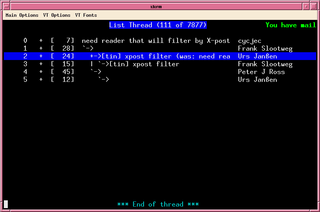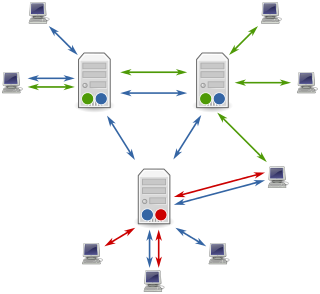A kill file is a file used by some Usenet reading programs to discard articles matching some unwanted patterns of subject, author, or other header lines. Adding a person or subject to one's kill file means that person or topic will be ignored by one's newsreader in the future. By extension, the term may be used for a decision to ignore the person or subject in other media.
A Usenet newsgroup is a repository usually within the Usenet system, for messages posted from users in different locations using the Internet. They are discussion groups and are not devoted to publishing news. Newsgroups are technically distinct from, but functionally similar to, discussion forums on the World Wide Web. Newsreader software is used to read the content of newsgroups.

In computing, a system call is the programmatic way in which a computer program requests a service from the operating system on which it is executed. This may include hardware-related services, creation and execution of new processes, and communication with integral kernel services such as process scheduling. System calls provide an essential interface between a process and the operating system.

A news server is a collection of software used to handle Usenet articles. It may also refer to a computer itself which is primarily or solely used for handling Usenet. Access to Usenet is only available through news server providers.

InterNetNews (INN) is a Usenet news server package, originally released by Rich Salz in 1991, and presented at the Summer 1992 USENIX conference in San Antonio, Texas. It was the first news server with integrated NNTP functionality.
The Network News Transfer Protocol (NNTP) is an application protocol used for transporting Usenet news articles (netnews) between news servers, and for reading/posting articles by the end user client applications. Brian Kantor of the University of California, San Diego, and Phil Lapsley of the University of California, Berkeley, wrote RFC 977, the specification for the Network News Transfer Protocol, in March 1986. Other contributors included Stan O. Barber from the Baylor College of Medicine and Erik Fair of Apple Computer.

B News was a Usenet news server developed at the University of California, Berkeley by Matt Glickman and Mary Ann Horton as a replacement for A News. It was used on Unix systems from 1981 into the 1990s and is the reference implementation for the de facto Usenet standard described in RFC 850 and RFC 1036. Releases from 2.10.2 were maintained by UUNET founder Rick Adams.

A News, or Netnews Version A, originally known simply as news, was the first widely distributed program for serving and reading Usenet newsgroups. The program, written at Duke University by Steve Daniel and Tom Truscott, was released on a tape given out at the June 1980 USENIX conference held at the University of Delaware. Steve Daniel from Duke offered a presentation on the then-new Usenet network and invited attendees to join.
Gmane is an e-mail to news gateway. It allows users to access electronic mailing lists as if they were Usenet newsgroups, and also through a variety of web interfaces. Since Gmane is a bidirectional gateway, it can also be used to post on the mailing lists. Gmane is an archive; it never expires messages. Gmane also supports importing list postings made prior to a list's inclusion on the service.
Google Groups is a service from Google that provides discussion groups for people sharing common interests. The Groups service also provides a gateway to Usenet newsgroups via a shared user interface.
dd is a command-line utility for Unix, Plan 9, Inferno, and Unix-like operating systems and beyond, the primary purpose of which is to convert and copy files. On Unix, device drivers for hardware and special device files appear in the file system just like normal files; dd can also read and/or write from/to these files, provided that function is implemented in their respective driver. As a result, dd can be used for tasks such as backing up the boot sector of a hard drive, and obtaining a fixed amount of random data. The dd program can also perform conversions on the data as it is copied, including byte order swapping and conversion to and from the ASCII and EBCDIC text encodings.
Forté Agent is an email and Usenet news client used on the Windows operating system. Agent was conceived, designed and developed by Mark Sidell and the team at Forté Internet Software in 1994 to address the need for an online/offline newsreader which capitalized on the emerging Windows GUI framework. By 1995, Agent had expanded to become a full-featured email client and remains a widely used application for integrating news and email communication on Windows. Agent supports POP email but not IMAP.

tin is an open-source text-based and threaded news client, used to read and post messages on the Usenet global communications network.

A newsreader is an application program that reads articles on Usenet distributed throughout newsgroups. Newsreaders act as clients which connect to a news server, via the Network News Transfer Protocol (NNTP), to download articles and post new articles. In addition to text-based articles, Usenet is also used to distribute binary files, generally in dedicated "binaries" newsgroups.
NOV, or News Overview, is a widely deployed indexing method for Usenet articles, also found in some Internet email implementations. Written in 1992 by Geoff Collyer, NOV replaced a variety of incompatible indexing schemes used in different client programs, each typically requiring custom modifications to each news server before they could be used. In modern NNTP implementations, NOV is exposed as the XOVER and related commands.
Newsbin Pro is a shareware Usenet newsreader client for Microsoft Windows. It is developed by DJI Interprises
yProxy is a Network News Transfer Protocol (NNTP) proxy server for the Windows operating system. yProxy's main function is to convert yEnc-encoded attachments to UUE-encoded attachments on the fly. The main purpose of this is to add functionality to NNTP newsreaders that do not have native support for yEnc. The inventor of yEnc recommends yProxy for use by Windows users whose newsreaders do not support yEnc decoding.

Usenet is a worldwide distributed discussion system available on computers. It was developed from the general-purpose Unix-to-Unix Copy (UUCP) dial-up network architecture. Tom Truscott and Jim Ellis conceived the idea in 1979, and it was established in 1980. Users read and post messages to one or more topic categories, known as newsgroups. Usenet resembles a bulletin board system (BBS) in many respects and is the precursor to the Internet forums that have become widely used. Discussions are threaded, as with web forums and BBSs, though posts are stored on the server sequentially.
Easynews, Inc is a HW Media Usenet/newsgroup reseller. Founded in 1994, Easynews service is available to individual users through a subscription model and as an outsourced service to internet service providers. Easynews offers Usenet access both through traditional Network News Transfer Protocol (NNTP) servers as well as a web interface using a standard web browser.







